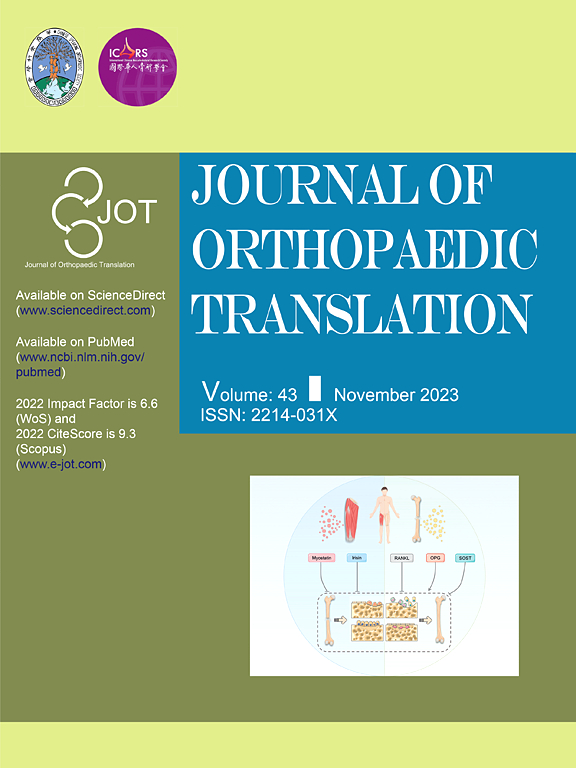一种含有壳聚糖和 rhBMP-2 的可生物降解磷酸镁水泥,设计用于骨缺损修复
IF 5.9
1区 医学
Q1 ORTHOPEDICS
引用次数: 0
摘要
背景骨缺损的修复一直是临床医学的一大难题。为了解决这一难题,医生们通常采用自体骨移植、异体骨移植和人工骨替代物。然而,前两种方法可能会造成额外的创伤和并发症,而异体骨移植则存在免疫排斥和疾病传播的风险。磷酸镁骨水泥(MPC)作为一种人工骨替代物,一直是修复骨缺损的潜在生物材料,但由于其机械强度不足和骨诱导活性差,其临床应用受到限制。结果经过化学成分改性后,CHI-rhBMP2 MPC 具有可控的降解率、适中的凝结时间、适当的引导温度、良好的注射性和更高的初始强度。体外试验表明,CHI-rhBMP2 MPC 可促进细胞增殖和粘附,并有助于成骨细胞分化和矿化。此外,还将骨水泥材料植入兔股骨髁,进行体内骨整合评估。结果显示,CHI-rhBMP2 MPC周围长出了更多的新骨,验证了骨结合能力的提高。转录组分析表明,病灶粘附、叉头盒O(FoxO)结论:这项研究为合理设计潜在的骨修复候选材料提供了一种新策略。本文章由计算机程序翻译,如有差异,请以英文原文为准。
A biodegradable magnesium phosphate cement incorporating chitosan and rhBMP-2 designed for bone defect repair
Background
The repair of bone defects has always been a significant challenge in clinical medicine. To address this challenge, doctors often utilize autologous bone grafts, allogeneic bone grafts and artificial bone substitutes. However, the former two methods may result in additional trauma and complications, while allogeneic bone grafts carry the risks of immune rejection and disease transmission. Magnesium phosphate cement (MPC), as a artificial bone substitutes, has been a potential biomaterial for repairing bone defects, but its clinical application is limited by insufficient mechanical strength and poor osteoinductive activity.
Methods
In this study, the cement liquid phase base on rhBMP-2 and chitosan solution into MPC were obtained and investigated. After mixing with a cement liquid, the structural and phase composition, morphology, chemical structure, setting time, compressive strength, degradation behavior, solubility, and cellular responses and bone regeneration in response to CHI-rhBMP2 MPC were investigated in vitro and in vivo.
Results
After the chemical component modification, CHI-rhBMP2 MPC possessed controllable degradation rate, moderate setting time, appropriate cuing temperature, good injectability, and improved initial strength. In vitro tests showed that the CHIrhBMP2 MPC could promote cell proliferation and adhesion, as well as that contribute to osteoblast differentiation and mineralization. In addition, cement materials were implanted into the rabbit femoral condyles for in vivo osseointegration evaluation. The results displayed that more new bone grew around CHI-rhBMP2 MPC, verifying improved osseointegration capacity. Transcriptome analysis revealed that focal adhesion, Forkhead box O(FoxO) signaling pathway and P13K/AKT signaling pathway were may involved in CHI-rhBMP2 MPC induced new bone formation.
Conclusion
This work provides a new strategy for the rational design of potential bone repair candidate materials.
求助全文
通过发布文献求助,成功后即可免费获取论文全文。
去求助
来源期刊

Journal of Orthopaedic Translation
Medicine-Orthopedics and Sports Medicine
CiteScore
11.80
自引率
13.60%
发文量
91
审稿时长
29 days
期刊介绍:
The Journal of Orthopaedic Translation (JOT) is the official peer-reviewed, open access journal of the Chinese Speaking Orthopaedic Society (CSOS) and the International Chinese Musculoskeletal Research Society (ICMRS). It is published quarterly, in January, April, July and October, by Elsevier.
 求助内容:
求助内容: 应助结果提醒方式:
应助结果提醒方式:


